
12-08: Energy & Metabolism
Kinetic & Potential Energy
Metabolism: the sum of all chemical reactions needed to sustain life
Energy is the ability to do work (movement)
Types of energy:
Kinetic: motion
Potential (chemical potential energy): energy contained/stored in chemical bonds within a molecule
First law of thermodynamics: energy cannot be created or destroyed - it can only be converted from one form to another
Some reactions produce or take up more energy than they require
Metabolism
Metabolism = anabolism + catabolism
Anabolism: builds up
Catabolism: breaks down
The sum of all chemical reactions
In a reaction, bonds between reactants are broken down and bonds between products are formed
Energy is absorbed when reactant bonds break and energy is needed
Energy is released when product bonds form

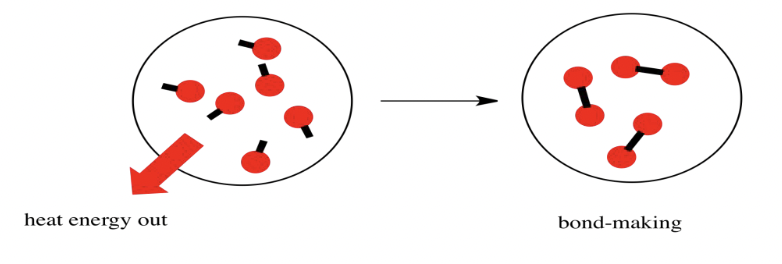
Anabolic Reactions
Build complex substances from smaller subunits
Overall require the input of energy to occur
Endergonic reactions: a need for energy
E.g. photosynthesis

Catabolic Reactions
Breakdown of complex substances
Overall release energy
Exergonic reactions: release of energy
Energy can be used for other jobs
E.g. cellular respiration

Exothermic vs. Endothermic
Enthalpy (∆H): a measure of the energy in a system, related to the amount of heat released or absorbed by a reaction
Exothermic reactions: ∆H < 0 (negative) – releases more thermal energy than they absorb
Products have less potential energy than reactants
Endothermic reactions: ∆H > 0 (positive) – absorbs more thermal energy than it releases
Chemical reactions need activation energy for a reaction to happen
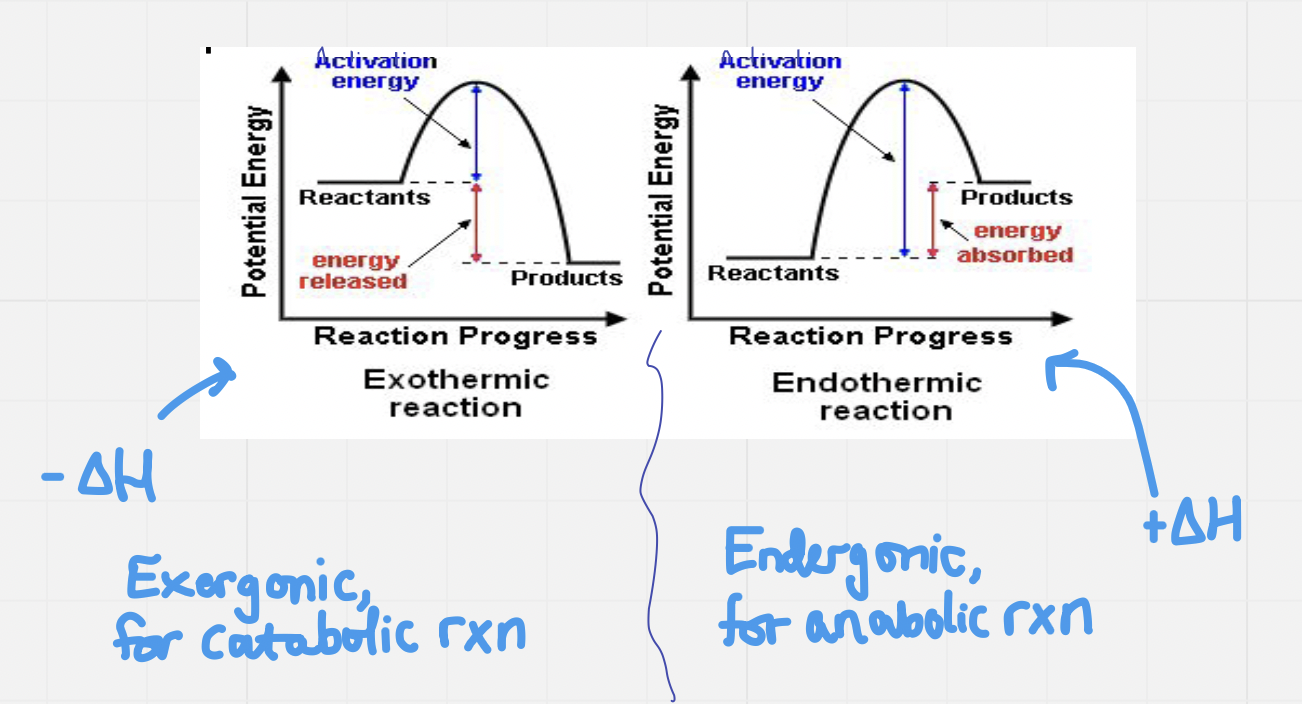
Energy Loss
Second law of thermodynamics: in every energy conversion, some energy becomes unusable, thus increasing the entropy of the universe
Heat is the typical form of loss of usual energy – it contributes to the increasing disorder in the surroundings
Entropy (∆S): measure of randomness/disorder
+∆S: more disorder
-∆S: less disorder
Gibbs Free Energy
The most useful kind of energy
In a chemical change, since some energy is lost to entropy, the usable remainder is called Gibbs Free Energy
Exergonic reactions release free energy (-∆G) and are spontaneous – i.e. don’t need certain conditions to occur, will continue as long as there is sufficient reactant w/o a continuous input of free energy
Endergonic reactions absorb free energy (+∆G) and are not spontaneous – i.e. they absorb more free energy than it produces and it won’t happen with a continual source because of this
Spontaneous: don’t need a continual source of energy, once they hit their activation energies they will occur (e.g. once the match is lit, the fire continues)
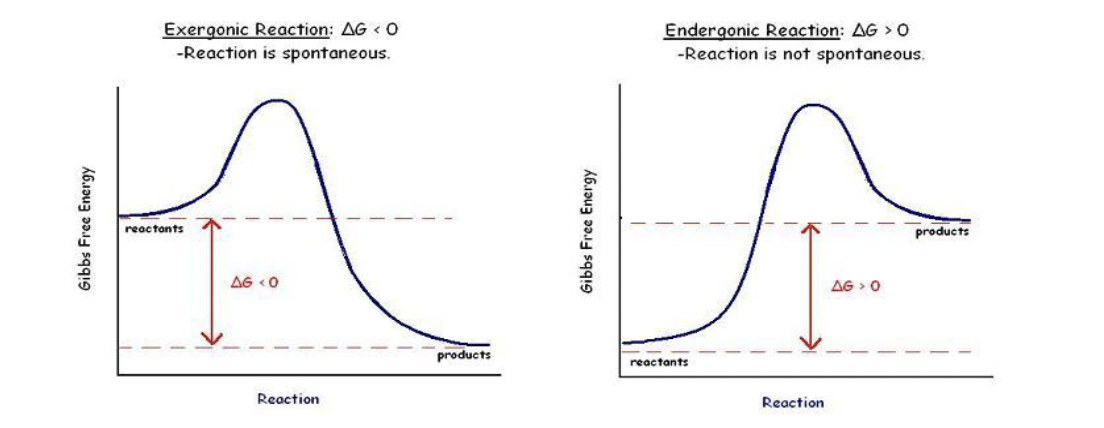
Spontaneous Reactions
Reactions that release free energy (-∆G) are spontaneous
Spontaneous reactions are those that will continue on their own once started (after activation energy)
Total energy change/enthalpy(∆H) and total disorder change/entropy (∆S) both play a key role in determining whether or not a reaction will be spontaneous (along with temperature)
∆G = ∆H --- T∆S
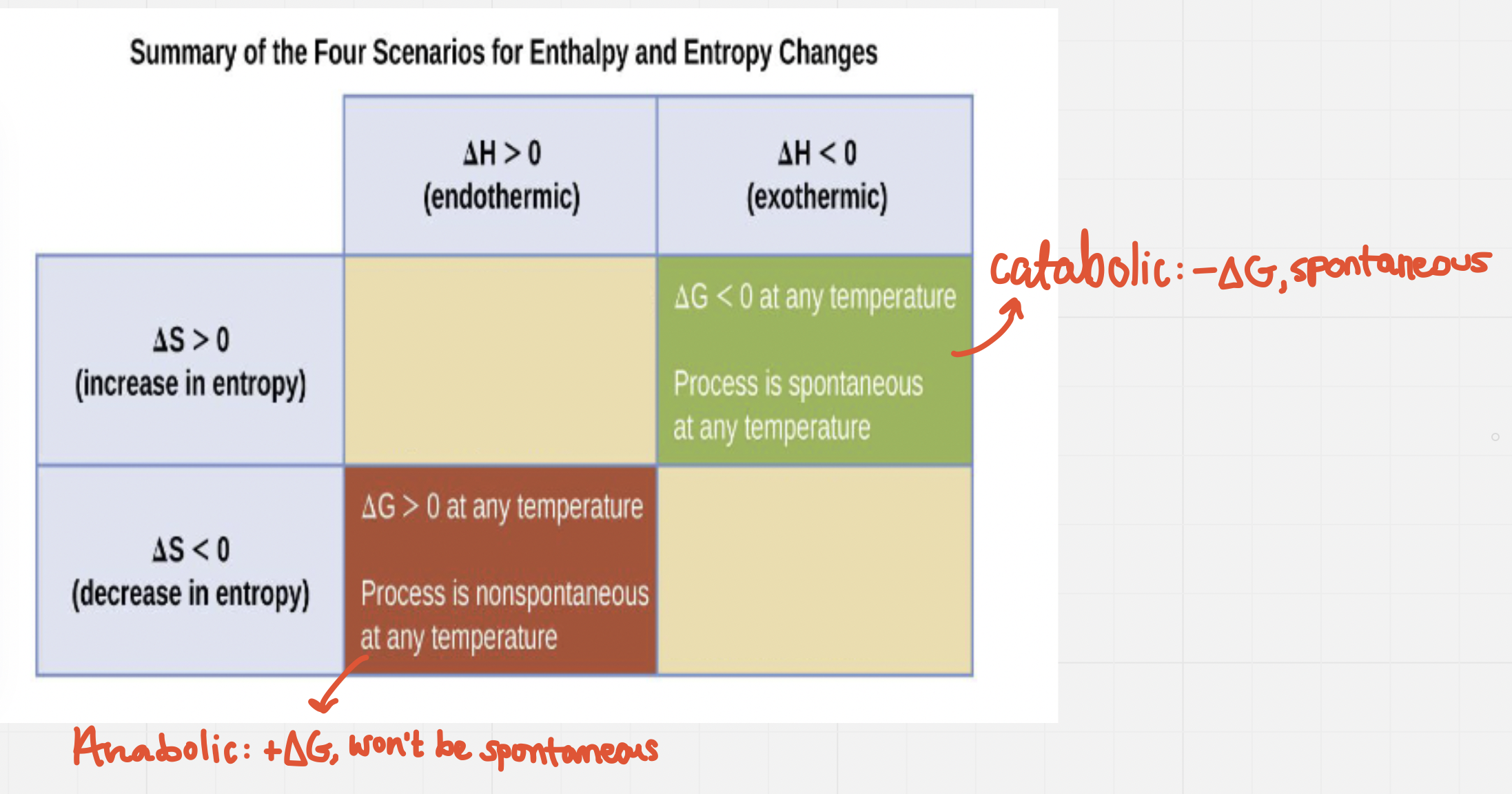
Metabolic Pathways
Catabolic pathways
Break down complex molecules into simple ones
Release free energy – spontaneous (-∆G)
Anabolic pathways
Build more complex molecules from simple ones
Absorb free energy – non spontaneous (+∆G)
In order for non spontaneous reactions to occur, they must be coupled with spontaneous ones
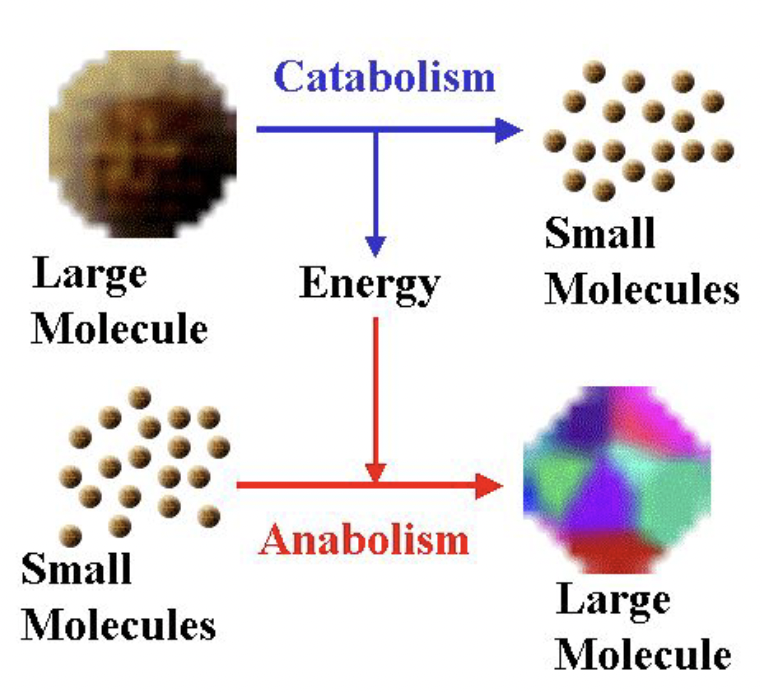
ATP Hydrolysis
Hydrolysis: breaking something down (catabolic)
Energy for endergonic reactions in cells is mostly provided by coupling the reaction with the hydrolysis of ATP
When water reacts with it, it breaks it into ADP and the phosphate bonds to a reactant thus making it more reactive, provides energy
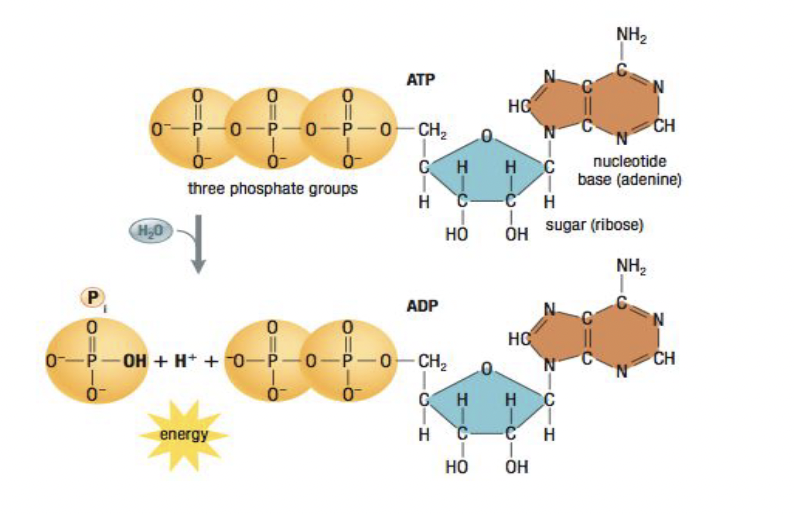
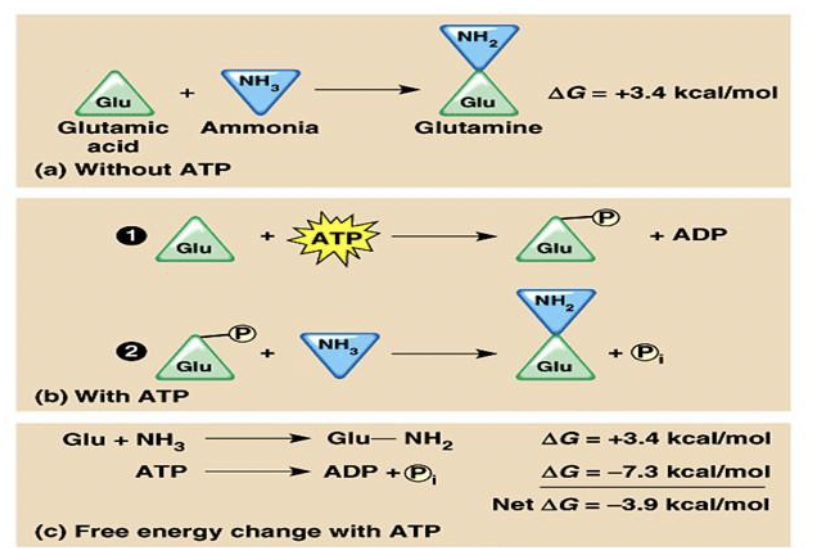
Coupled Reactions
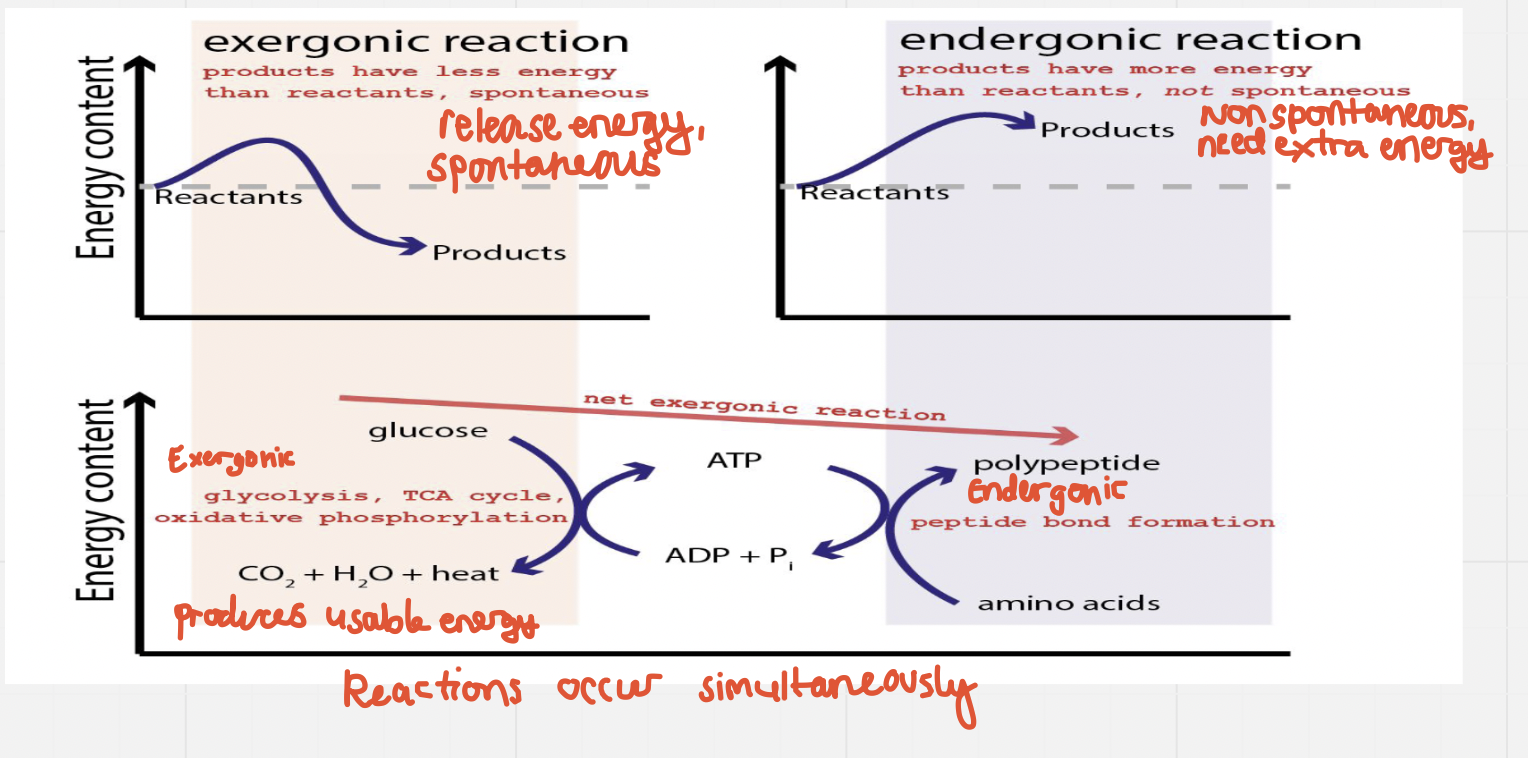
12-08: Energy & Metabolism
Kinetic & Potential Energy
Metabolism: the sum of all chemical reactions needed to sustain life
Energy is the ability to do work (movement)
Types of energy:
Kinetic: motion
Potential (chemical potential energy): energy contained/stored in chemical bonds within a molecule
First law of thermodynamics: energy cannot be created or destroyed - it can only be converted from one form to another
Some reactions produce or take up more energy than they require
Metabolism
Metabolism = anabolism + catabolism
Anabolism: builds up
Catabolism: breaks down
The sum of all chemical reactions
In a reaction, bonds between reactants are broken down and bonds between products are formed
Energy is absorbed when reactant bonds break and energy is needed
Energy is released when product bonds form


Anabolic Reactions
Build complex substances from smaller subunits
Overall require the input of energy to occur
Endergonic reactions: a need for energy
E.g. photosynthesis

Catabolic Reactions
Breakdown of complex substances
Overall release energy
Exergonic reactions: release of energy
Energy can be used for other jobs
E.g. cellular respiration

Exothermic vs. Endothermic
Enthalpy (∆H): a measure of the energy in a system, related to the amount of heat released or absorbed by a reaction
Exothermic reactions: ∆H < 0 (negative) – releases more thermal energy than they absorb
Products have less potential energy than reactants
Endothermic reactions: ∆H > 0 (positive) – absorbs more thermal energy than it releases
Chemical reactions need activation energy for a reaction to happen

Energy Loss
Second law of thermodynamics: in every energy conversion, some energy becomes unusable, thus increasing the entropy of the universe
Heat is the typical form of loss of usual energy – it contributes to the increasing disorder in the surroundings
Entropy (∆S): measure of randomness/disorder
+∆S: more disorder
-∆S: less disorder
Gibbs Free Energy
The most useful kind of energy
In a chemical change, since some energy is lost to entropy, the usable remainder is called Gibbs Free Energy
Exergonic reactions release free energy (-∆G) and are spontaneous – i.e. don’t need certain conditions to occur, will continue as long as there is sufficient reactant w/o a continuous input of free energy
Endergonic reactions absorb free energy (+∆G) and are not spontaneous – i.e. they absorb more free energy than it produces and it won’t happen with a continual source because of this
Spontaneous: don’t need a continual source of energy, once they hit their activation energies they will occur (e.g. once the match is lit, the fire continues)

Spontaneous Reactions
Reactions that release free energy (-∆G) are spontaneous
Spontaneous reactions are those that will continue on their own once started (after activation energy)
Total energy change/enthalpy(∆H) and total disorder change/entropy (∆S) both play a key role in determining whether or not a reaction will be spontaneous (along with temperature)
∆G = ∆H --- T∆S

Metabolic Pathways
Catabolic pathways
Break down complex molecules into simple ones
Release free energy – spontaneous (-∆G)
Anabolic pathways
Build more complex molecules from simple ones
Absorb free energy – non spontaneous (+∆G)
In order for non spontaneous reactions to occur, they must be coupled with spontaneous ones

ATP Hydrolysis
Hydrolysis: breaking something down (catabolic)
Energy for endergonic reactions in cells is mostly provided by coupling the reaction with the hydrolysis of ATP
When water reacts with it, it breaks it into ADP and the phosphate bonds to a reactant thus making it more reactive, provides energy


Coupled Reactions

 Knowt
Knowt